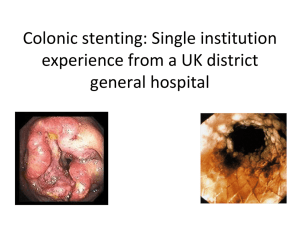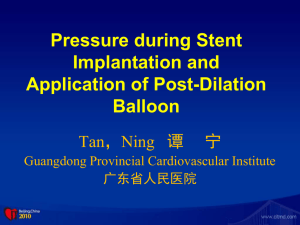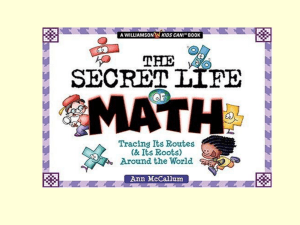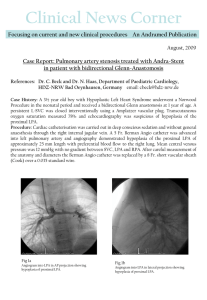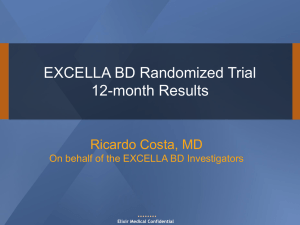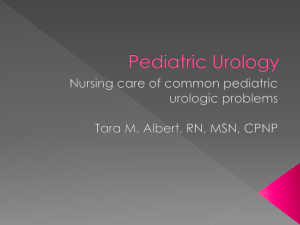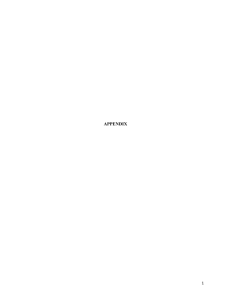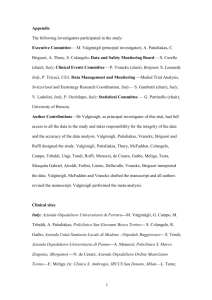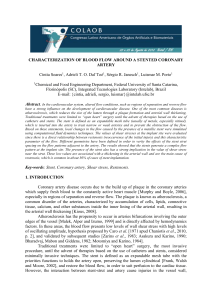Histomorphometry_for_web - Barts and The London School of
advertisement
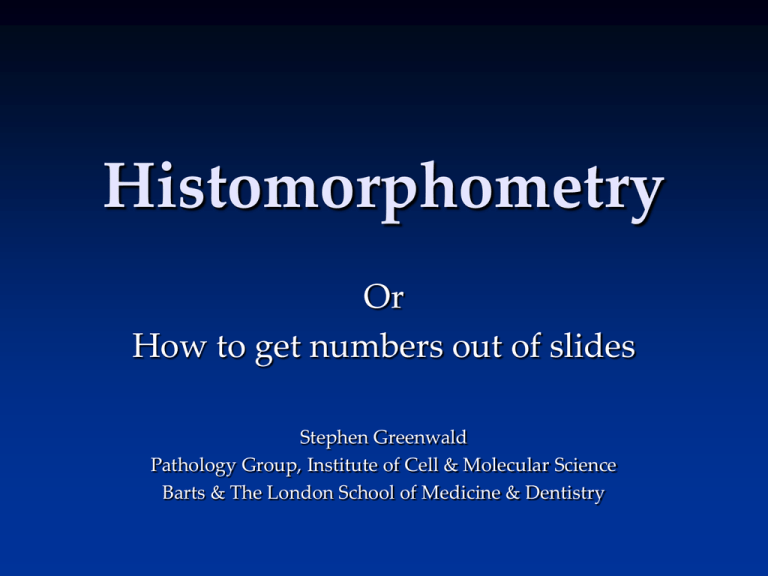
Histomorphometry Or How to get numbers out of slides Stephen Greenwald Pathology Group, Institute of Cell & Molecular Science Barts & The London School of Medicine & Dentistry Outline What is morphometry? Why histomorphometry? Measurement methods Standard processes in computerised histomorph. “Manual” Computerised Image capture Enhancement Thresholding Measuring Micro CT of stented arteries What is morphometry? A body of methods for obtaining numerical information about the shape and size of a structure in terms of quantities such as: volume surface area relative amounts of each component orientation, interconnections distribution of substructures etc. Why histomorphometry? When applied to biological tissue examined microscopically it useful in correlating structure and function e.g. Alveolar or gut villus surface area Arterial composition and elasticity Quantification of Hyperplasia, dysplasia, hypertrophy Immunohistochemical or flourescent markers Area or intensity Major challenge To extract information about large 3-D structures from microscopic measurements on thin 2-D sections To do this histomorphometry uses the: Delesse Principle Delesse Principle “In a rock composed of a number of minerals, the area occupied by any given mineral is proportional to the volume of the mineral in the rock” Repeated determinations of the area fraction will yield an estimate of the volume fraction. The more determinations; the better the estimate. Delesse A. (1847) Procede mechanique pour determines la composition des roches. Comptes Rendus de l’Academie des Science (Paris) 25, 544) How to estimate area fraction paper cutting and weighing planimetry Planimeter How to estimate area fraction paper cutting and weighing planimetry dot counting Dot counting Nuclear area/cell area = number of dots in nuclei/number of dots in cell Absolute area of a structure = number of dots in structure x area of dot square How to estimate area fraction paper cutting and weighing planimetry dot counting square counting Square counting 34 squares 7 squares How to estimate area fraction paper cutting and weighing planimetry dot counting square counting pixel counting in a digital image semi- or fully automatic system Computerised histomorphometry TV camera ADC Microscope LUT Video memory ADC Image processor Main processor Storage LUT User. mouse, light-pen Stimulants Pixel counting Pixel counting Recognising objects by colour More difficult measurements length surface area alveoli, gut villi etc. counting discrete objects seminiferous tubules cells, nuclei, alveoli, elastic lamellae etc. Size distribution cells, nuclei, tumours etc. How to estimate length (Buffon’s needle problem) If you drop a nail/needle on the floor, what is the probability it will come to rest over a crack between the floor boards? Louis le Clerc, Compte de Buffon, (1707 -1788) French naturalist & polymath Buffon needle problem d l The probability (p) of the needle (or nail) landing on a join depends on the length of the needle (l), the width of the boards (d) and the angle it makes with the direction of the boards (). The angle determines the projected (i.e. effective) length of the nail, (lproj) p lproj where l proj is the average projected lengt h d lpro j lproj 2l 2 cos.d 0 2l p 2l d Inverse problem; i.e. throw the grid at the nails Imagine a contour of length L composed of small elements, l Probability (p) of an intersection :is 2l p d Number of "throws" is: Now throw the grid (spacing, d) at the nails (i.e. the small elements) L l Number of int ersections N int is the number of "throws" t imes the probability of an intersect ion L 2l N int . l d Rearranging t he above expression, we can calculate the total length L)( d.N int L 2 Villus and crypt length measurements How to measure surface area Measure absolute volume (V) of entire organ Estimate tissue volume fraction from area fraction Archimedes, weight (knowing density) calculate tissue volume Count intercepts (Nint) using grid of total length (L) SA 2VN int L Pattern recognition normal v abnormal morphology displasia, metaplasia Normal nucleus: Area = 10m2, perimeter =14m Abnormal nucleus: Area = 10m2, perimeter =26m counting poorly stained structures nuclei, nuclear organelles, leucocytes Standard processes Image capture Enhancement contrast/colour background correction Thresholding (identifying structures of interest) 10kB colour intensity shape Measurement 1.5MB area, perimeter, counting 1kB Image enhancement: shade correction Uneven background illumination Image enhancement: shade correction Original image with uneven illumination Image enhancement: shade correction Shade corrected image Contrast enhancement: Original Enhanced Thresholding by colour Thresholded Enhanced Measurement Section Field Area [sq micron] Elastin [%] Collagen [%] VSMC [%] E+C [%] V+E [%] V+C [%] Unthreshed [%] Total [%] 155-05-c2 1 22437.95 19.29 43.8 31.37 0 0 2.29 7.53 100.23 2 17619.23 22.46 39.39 29.52 0 0.47 0 8.3 100 3 17424.26 21.83 37.6 32.66 0 0.31 1.56 8.71 99.97 5 16765.18 26.06 40.76 31.91 0.02 0 0.56 2.58 101.78 18561.655 22.41 40.3875 31.365 0.005 0.195 1.1025 6.78 100.495 152-05-d 1 2 3 4 21366.93 18108.37 18895.89 20573.07 19736.065 23.61 19.64 18.56 20.61 20.605 43.85 55.43 48.15 60.18 51.9025 29.32 35.24 30.12 26.84 30.38 0 0.87 0 0 0.2175 0 2.37 1.71 1.27 1.3375 0.88 8.99 0 6 3.9675 3.93 1.62 3.21 -1.4 1.84 100.27 101.98 100.52 100.98 100.9375 145-05-d 1 2 3 4 18244.94 20463.62 15651.55 20284.31 18661.105 16.79 18.13 15.13 17.11 16.79 52.13 60.02 62.22 58.67 58.26 24.36 29.14 27.6 28.75 27.4625 0 2.63 1.91 0.34 1.22 1.07 1.64 0.97 1.57 1.3125 0.62 3.51 2.56 4.7 2.8475 8.8 1.72 1.81 3.23 3.89 100.39 101.23 101.33 101.15 101.025 143-05-D 1 2 3 4 17682.66 16752.71 18252.77 16264.18 17238.08 20.24 19.38 18.52 14.28 18.105 54.25 58.03 61.73 55.54 57.3875 24.5 23.25 19.23 24.95 22.9825 1.99 1.9 0 2.23 1.53 0.07 0.18 0.37 0.44 0.265 0.01 0.01 2.3 0 0.58 4.16 2.75 3.38 7.32 4.4025 101.08 101.33 100.99 100.64 101.01 157-05-D 1 2 3 4 14207.13 17832.78 16970.9 15497.26 16127.0175 17.18 18.35 17.73 24.48 19.435 66.19 59.46 56.9 56.19 59.685 12.97 15.65 23.37 17.1 17.2725 2.19 0 0 0.96 0.7875 0.56 0.44 0.49 1.24 0.6825 0 0.29 5.44 0.43 1.54 6.57 6.8 5.03 2.09 5.1225 100.72 100.13 99.71 100.91 100.3675 The Effect of Stent Oversize Stiffness & Structure on restenosis In vivo radiographic measurement of stent dimensions in pig carotid and iliac arteries Development of a micro CT method for stented vessel morphometry on excised arteries Study aims To quantify degree of restenosis Effect of stent oversize and stiffness To compare two stent types SMART stent (a standard design) Major problem is restenosis Compliant ended stent (a novel design). Developed by collaborators, J.E. Moore & Colleagues at Texas A&M Hypothesis By matching the compliance of the stent to that of the “native” artery, flow disturbances and bending stress at the stent/artery junction is reduced and hence restenosis is minimised Stents used in the Study SMART stent Compliant Ended Stent Compliance Matching Stent Rigid in the centre to provide recoil resistance Parabolic and cantilevered struts gradual change in compliance reduces stress concentration and bending Less disturbed flow Methods 65 stents implanted in the iliac and carotid arteries of 17 Large White pigs Lumen diameter determined before and after implantation by angiography Follow-up angiography on days 3,7 and 28 At day 28 the arteries were pressure perfused and removed for histology and CT scanning Vessel dimensions determined by automatic edge detecting algorithm Lumen diameter [mm] 7 6 5 4 0 5 10 15 20 Position along stent [mm] 25 30 35 Micro CT of excised vessels Vessels pressure fixed in situ (10% formol saline) Excised and immersed in oil based contrast medium Custom built Micro CT scanner (Dental Biophysics QMUL) Voxel size (30 x 30 x 30µm) Images processed on custom software developed under KS400 image analysis system A trip through a stented artery QuickTime™ and a decompressor are needed to see this picture. One of about 1200 slices cut perpendicular to the long axis of the vessel Image processing Original slice Thresholded Stent struts Media/Adventita only Circle fitted Slice measurements (CE Stent) Lumen and stent area [mm2] Lumen circularity 18 1.00 16 0.95 14 Lumen Stent 12 0.90 10 8 0.85 6 0.80 4 0 10 20 Distance [mm] 30 40 0 10 20 Distance [mm] 30 40 3D reconstruction And rendering Conclusions Histomorphometry is useful for counting and measuring clearly defined structures Limited by a lack of “intelligent” software For histopathologists, may be valuable for quantifying prognosis Extremely difficult to better the human eye-brain combination for pattern recognition/diagnosis Measuring ratio or distribution of different tumour markers No immediate cause for alarm amongst histopathologists…but watch this space.
